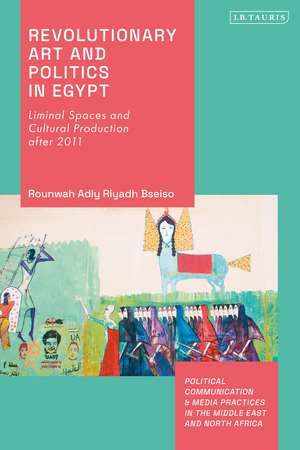Revolutionary Art and Politics in Egypt: Liminal Spaces and Cultural Production After 2011: Political Communication and Media Practices in the Middle East and North Africa
Autor Rounwah Adly Riyadh Bseisoen Limba Engleză Paperback – 24 iul 2024
| Toate formatele și edițiile | Preț | Express |
|---|---|---|
| Paperback (1) | 191.48 lei 6-8 săpt. | |
| Bloomsbury Publishing – 24 iul 2024 | 191.48 lei 6-8 săpt. | |
| Hardback (1) | 510.83 lei 6-8 săpt. | |
| Bloomsbury Publishing – 25 ian 2023 | 510.83 lei 6-8 săpt. |
Preț: 191.48 lei
Preț vechi: 249.45 lei
-23% Nou
Puncte Express: 287
Preț estimativ în valută:
36.66€ • 37.72$ • 30.90£
36.66€ • 37.72$ • 30.90£
Carte tipărită la comandă
Livrare economică 28 februarie-14 martie
Preluare comenzi: 021 569.72.76
Specificații
ISBN-13: 9780755644797
ISBN-10: 0755644794
Pagini: 248
Ilustrații: 70 bw illus
Dimensiuni: 156 x 234 x 25 mm
Greutate: 0.35 kg
Editura: Bloomsbury Publishing
Colecția I.B.Tauris
Seria Political Communication and Media Practices in the Middle East and North Africa
Locul publicării:London, United Kingdom
ISBN-10: 0755644794
Pagini: 248
Ilustrații: 70 bw illus
Dimensiuni: 156 x 234 x 25 mm
Greutate: 0.35 kg
Editura: Bloomsbury Publishing
Colecția I.B.Tauris
Seria Political Communication and Media Practices in the Middle East and North Africa
Locul publicării:London, United Kingdom
Caracteristici
Provides a first substantive academic analysis of post 2011 Egyptian street artists and the intersection between art and politics in the revolution
Notă biografică
Rounwah Adly Riyadh Bseiso is an educator and researcher who holds a PhD from SOAS, University of London, UK. Her main interests lie in issues relating to media and political practices, human rights law & international development, and the decolonization of knowledge in the S.W.A.N.A. (South West Asian/North African) region. Her academic writing has been published in peer review collections such as Narrating Conflict in the Middle East: Discourse, Image and Communications Practices in Lebanon and Palestine (I.B.Tauris, 2013).
Cuprins
Introduction, conceptual framework, brief background to contextualize the setting of the political and cultural field in Egypt.1. The First Phase: The first 18 days of the Egyptian Revolution2. The Second Phase of the Revolution: SCAF Rule3. The Third Phase of the Revolution: Morsi's Presidency4. Can Revolutionary Art exist in the Aftermath of the Revolution? The Fieldwork MomentConclusionBiographyReferences
Recenzii
This book is for me, and people like me: academics and their ilk of 'the Latin West' who over-romanticise and over-celebrate the Egyptian revolution, and the 'Arab Spring' more generally, because we are uneducated in history, context, and veracity. We are ignorant of any real sense of the particularities of the political-cultural event that is the 25 January revolution in 2011 (as well as its genealogies and its aftermath), of the local, of the street, of protest and dissent and commemoration, of community and solidarity, of a time when all art was revolutionary art, of cautious hope and inevitable disenchantment. Rounwah Adly Riyadh Bseiso's Revolutionary Art and Politics in Egypt is a necessary corrective.





